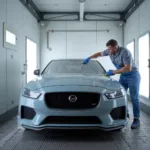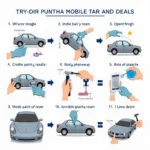Car paint chip repair often involves using rubbing compound, a crucial step in restoring your car’s finish. This article delves into the intricacies of using rubbing compound effectively for car paint chip repair, ensuring a professional-looking result. We’ll guide you through the process, from assessing the damage to achieving a flawless finish, offering expert tips and tricks along the way.
Understanding Car Paint Chip Repair and Rubbing Compound
Before diving into the how-to, it’s important to understand what car paint chips are and the role rubbing compound plays in their repair. Paint chips are small areas of damage where the paint has been removed, exposing the underlying metal or primer. They can be caused by rocks, road debris, or even minor impacts. Rubbing compound is an abrasive paste used to smooth out imperfections in the paint, such as scratches, swirl marks, and the uneven surface left after filling a paint chip. It works by leveling the paint’s clear coat, restoring its shine and uniformity. You can learn more about repairing chips in car paint here: repair chips in car paint.
Assessing the Damage: When to Use Rubbing Compound
Not all paint chips require rubbing compound. For very small chips, a touch-up paint pen might suffice. However, deeper chips that require filling will likely need rubbing compound to blend the repair seamlessly with the surrounding paint. Examine the chip closely. If it’s deep enough to feel with your fingernail or has created a noticeable rough patch, rubbing compound is probably necessary.
Step-by-Step Guide to Using Rubbing Compound for Car Paint Chip Repair
Here’s a comprehensive guide to effectively using rubbing compound after repairing a paint chip:
-
Clean the Area: Thoroughly wash and dry the area around the repaired chip. This removes any dirt or debris that could scratch the paint during the compounding process.
-
Apply Rubbing Compound: Apply a small amount of rubbing compound to a clean, soft microfiber cloth or applicator pad. Don’t use excessive pressure; let the compound do the work.
-
Rub in Circular Motions: Gently rub the compound onto the repaired area using small, overlapping circular motions. Focus on blending the edges of the repair with the surrounding paint.
-
Check Your Progress: Periodically wipe off the compound with a clean microfiber cloth to inspect your progress. You should see the repaired area becoming smoother and blending with the surrounding paint. car paint chip repair utah offers further insights on this.
-
Repeat if Necessary: If the repair is still visible or feels rough, repeat steps 3 and 4 until you achieve a smooth, even surface.
-
Polish and Wax: After you’re satisfied with the results, follow up with a polishing compound and wax to restore the paint’s shine and protect the repaired area. Find out more about related paint repairs at car bumper repair and paint.
Common Mistakes to Avoid
- Using Too Much Compound: Applying too much rubbing compound can make it difficult to remove and may even create new scratches.
- Applying Too Much Pressure: Excessive pressure can damage the paint and create swirl marks.
- Using a Dirty Cloth: A dirty cloth can introduce contaminants that scratch the paint.
- Skipping the Polishing and Waxing Steps: Polishing and waxing are essential for restoring shine and protecting the repaired area. You can also consider color-easy car paint pen scratch repair for minor scratches.
“When repairing paint chips, less is more. Start with a small amount of rubbing compound and gradually increase if needed. Patience and a gentle touch are key to achieving a professional finish.” – John Smith, Automotive Detailing Expert
Choosing the Right Rubbing Compound
Not all rubbing compounds are created equal. Some are more abrasive than others. For minor paint chip repairs, a fine-grit rubbing compound is generally recommended. If the chip is deeper or the surrounding paint is heavily oxidized, a medium-grit compound might be necessary. For more extensive damage, see how to repair damaged paint on car.
 Different Types of Rubbing Compound for Car Paint Chip Repair
Different Types of Rubbing Compound for Car Paint Chip Repair
Conclusion: Achieving a Flawless Finish with Car Paint Chip Repair and Rubbing Compound
Car paint chip repair using rubbing compound is a manageable DIY project that can save you money and restore your car’s appearance. By following these steps and avoiding common mistakes, you can achieve professional-looking results. Remember to choose the right rubbing compound and use a gentle touch for a flawless finish.
FAQ
- Can I use rubbing compound on all types of car paint?
- What’s the difference between rubbing compound and polishing compound?
- How long does it take for rubbing compound to dry?
- Can I apply rubbing compound by hand?
- How often should I use rubbing compound on my car?
- What should I do if I accidentally scratch the paint with rubbing compound?
- How can I remove excess rubbing compound?
Need help with your car paint chip repair? Contact us via WhatsApp: +1(641)206-8880, Email: [email protected]. Our 24/7 customer service team is ready to assist you.


